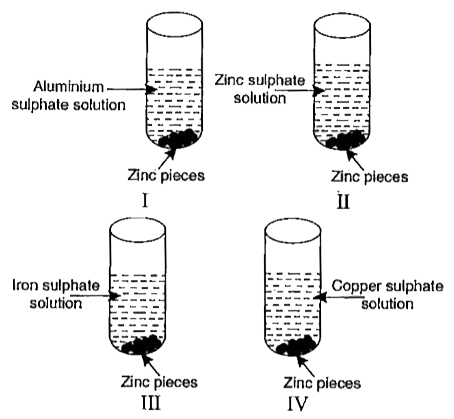A student added a piece of zinc metal each to four different test tubes containing different solutions as given below. The test tube in which no reaction was observed, contains
Al2(SO4)3
ZnSO4
FeSO4
CuSO4
The correct Answer is:D
To determine which test tube will show no reaction when zinc metal is added, we need to analyze the reactivity of zinc with the different solutions provided.
1. Identify the Reactivity of Zinc:
Zinc (Zn) is a moderately reactive metal. It can displace less reactive metals from their salts but cannot displace more reactive metals.
2. List the Solutions:
The solutions mentioned are:
- Aluminum sulfate (Al2(SO4)3)
- Zinc sulfate (ZnSO4)
- Iron sulfate (FeSO4)
- Copper sulfate (CuSO4)
3. Analyze Each Solution:
- Zinc with Aluminum Sulfate:
- Zinc is less reactive than aluminum. Therefore, zinc cannot displace aluminum from aluminum sulfate.
- No Reaction will occur.
- Zinc with Zinc Sulfate:
- Zinc cannot displace itself from its own salt (zinc sulfate).
- No Reaction will occur.
- Zinc with Iron Sulfate:
- Zinc is more reactive than iron. Therefore, zinc can displace iron from iron sulfate.
- Reaction will occur, producing zinc sulfate and iron.
- Zinc with Copper Sulfate:
- Zinc is more reactive than copper. Therefore, zinc can displace copper from copper sulfate.
- Reaction will occur, producing zinc sulfate and copper.
4. Conclusion:
The test tubes in which no reaction is observed are those containing aluminum sulfate and zinc sulfate.
Final Answer:
The test tube in which no reaction was observed contains Aluminum sulfate (Al2(SO4)3) or Zinc sulfate (ZnSO4).
Zinc (Zn) is a moderately reactive metal. It can displace less reactive metals from their salts but cannot displace more reactive metals.
The solutions mentioned are:
- Aluminum sulfate (Al2(SO4)3)
- Zinc sulfate (ZnSO4)
- Iron sulfate (FeSO4)
- Copper sulfate (CuSO4)
- Zinc with Aluminum Sulfate:
- Zinc is less reactive than aluminum. Therefore, zinc cannot displace aluminum from aluminum sulfate.
- No Reaction will occur.
- Zinc with Zinc Sulfate:
- Zinc cannot displace itself from its own salt (zinc sulfate).
- No Reaction will occur.
- Zinc with Iron Sulfate:
- Zinc is more reactive than iron. Therefore, zinc can displace iron from iron sulfate.
- Reaction will occur, producing zinc sulfate and iron.
- Zinc with Copper Sulfate:
- Zinc is more reactive than copper. Therefore, zinc can displace copper from copper sulfate.
- Reaction will occur, producing zinc sulfate and copper.
The test tubes in which no reaction is observed are those containing aluminum sulfate and zinc sulfate.
The test tube in which no reaction was observed contains Aluminum sulfate (Al2(SO4)3) or Zinc sulfate (ZnSO4).
Similar Questions
Zinc pieces were placed in each of the four test tubes containing different salt solutions as shown below:

In which cases will colour change be observed in solutions?
View SolutionA student addd few pieces of aluminium metal to two test tubes A and B containing aqueous solutions of iron sulphate and copper sulphate. In the second part of her experiment, the added iron metal to another test tubes C and D containing aqueous solutions of aluminium sulphate and copper sulphate.
In which test tube or test tubes will she observe colour change? On the basis of this experiment, state which one is the most reactive metal and why ?
View Solution
Knowledge Check
On addition of AgNO3 to four different test tubes containing different solution, one of them gave a white precipitate . It may be
ACHCl3BCaCL2CKNO3DCCl4A student performed the first set of experiments with four test tubes containing solutions and metal pieces as indicated in the figure. In the second set of experiments, the metal pieces are interchanged between test tubes P and Q and also between test tubes R and S.

In which test tube(s), no reaction will occur in both sets of experiments ?AP and QBRCSDR and SA student puts one big iron nail each in four test tubes containing solutions of zinc sulphate, aluminium sulphate, copper sulphate and iron sulphate. A reddish-brown coating was observed only on the surface of iron nail which was put in the solution of
Azinc sulphateBiron sulphateCcopper sulphateDaluminium sulphate.
A student addd few pieces of aluminium metal to two test tubes A and B containing aqueous solutions of iron sulphate and copper sulphate. In the second part of her experiment, the added iron metal to another test tubes C and D containing aqueous solutions of aluminium sulphate and copper sulphate.
In which test tube or test tubes will she observe colour change? On the basis of this experiment, state which one is the most reactive metal and why ?
View SolutionA student added water to sand and strach in different test tube .How will you differenitiate between the two on the basis of transparency?
View SolutionA student took four test tubes containing solutions of different colours marked I,II, III and IV as shown here. The test tubes containing copper sulphate solution and ferrous sulphate could be the tubes:

View SolutionA test tube containing some water is surrounded by melting ice (pure). Then, the water in the test tube will
View SolutionA student was studying reactions of metals with dilute NaOH at room temperature. The student took dilute NaOH in four different test tubes and added copper powder to test tube A, zinc dust to test tube B, aluminium powder to test tube C and iron powder to test tube D and observed effervesce in ________.
View Solution